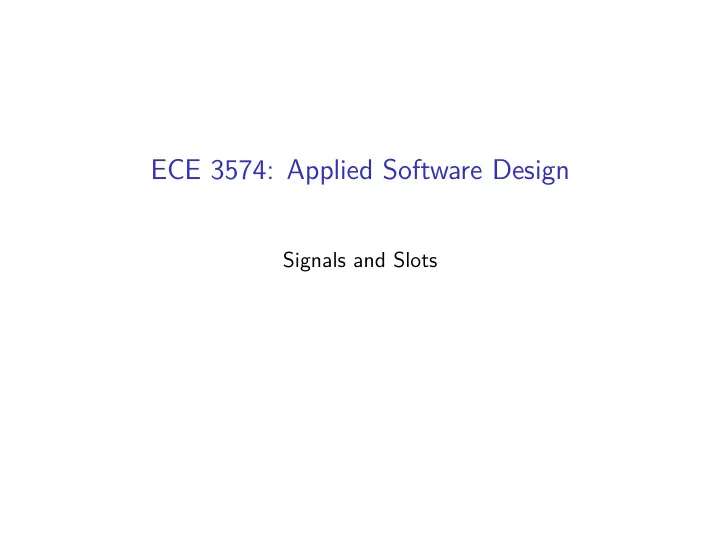

ECE 3574: Applied Software Design Signals and Slots
Announcements ◮ Milestone 2 is officially released today, due 10/24. ◮ I have to cancel my office hours this afternoon.
Today we will learn about a variation of the Observer design pattern that is used prominently within Qt, called signals and slots. ◮ Observer and Publish/Subscribe Pattern ◮ Observers as callback functions ◮ Observers using signals ◮ Qt signals ◮ Examples ◮ Exercise
The Observer or Publish / Subscribe design pattern is a way to communicate among objects without them knowing much about one another. Recall the notion of an event handler. ◮ To call the event handler we need a pointer or reference to the object handling the event ◮ This is an example of a callback function A callback is simply a pointer to a function.
Example 1: a simple callback function See callbacks.cpp
Example 2: using a member function as a callback See callbacks_methods.cpp
There are drawbacks to callbacks as illustrated in Example 1 and 2. ◮ They represent a one-to-one communication ◮ The communication is always-on Fixing this requires a good deal of effort to manage the callback connections. ◮ make the callback a list of callbacks ◮ call each callback in the list Factoring this code out into a library results in managed callbacks, or signals and slots .
Signals and Slots ◮ Signals (publishers) are callbacks with multiple targets or slots (receivers or subscribers). ◮ Signals are connected to slots ◮ Signals are emitted ◮ Slots connected to a signal are called when the signal is emitted This raises an important issue, how are return values from slots used? ◮ Some systems do not use them (Qt) ◮ Other systems provide a way to aggregate them (boost::signals)
C++ libraries that provide a signal/slot mechanism ◮ Boost is a very popular collection of C++ library that provides boost::signal. ◮ POCO is another popular collection that provides an event system that works like signals/slots. ◮ Qt has a signals and slots mechanism implemented as an extension of C++.
Qt signals and slots extend the syntax of C++. ◮ Every class that wants to communicate via signals and slots must derive from QObject directly or indirectly (derive from a subclass of QObject) ◮ The class should have the macro Q_OBJECT in its private section. ◮ slots are defined in a private, protected, or public section called slots and implemented ◮ signals are defined in a section called signals, but not implemented ◮ signals are emitted using the keyword emit ◮ connections are made using the QObject::connect function. The connections between signals and slots can be synchronous or queued.
An Example: a settings widget See qtmain.cpp . receiver_object.* , settings_widget.* , and settings.h .
Exercise See website
Next Actions and Reminders ◮ Read about integration tesing with QtTest ◮ Start working on Milestone 2!
Recommend
More recommend